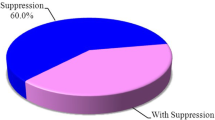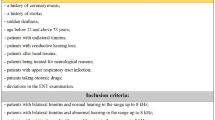Summary
81 cases of tinnitus were studied in order to find out the site of lesion. Tinnitus matching is helpful in objective assesment of tinnitus. Frequency of tinnitus is not helpful in differentiating cryptogenic from vibratory tinnitus. Coincidence of tinnitus frequency at the brows of the dip in the AC threshold curve is suggestive of cochlear lesion. Maskability indicates endorgan lesion and carries with it a better prognosis. Monotone or othe varieties of tinnitus can be masked with multiple tones in a good number of cases yielding a TINNITOGRAM. Inordinate discrepancy between the tinnitogram, AC threshold curve and the loudness of tinnitus suggests the presence of recruitment.
Endorgan lesion responds better to treatment than the ones associated with retrocochlear lesions, and hence this endeavour to localise the lesion is helpful in prognostication. Treatment and the audiological assesment regard to the effects of different types of treatment would be dealt with elsewhere.
Similar content being viewed by others
References
Curotto Costa, D.: Complementary test in the study of tinnitus auriun, Acta. Otolaryng (Stockh), 9 : 397, 1958.
Eisenberg, R. B.: Loudness, Recruitment & differential diagnosis, A.M.A. Arch Otolaryng, 68 : 199, 1958.
Fowler, E.P.: Head noises, significance, measurement & importance in diagnosis and treatment, A.M.A. Arch, Otolaryng, 32 : 903, 1940.
Fowler, E.P.: Tinnitus in the light of recent research, Ann. Otol. Rhi. Laryng 50 : 139, 1941.
Fowler, E.P. & Fowler, E.P. (Jr.): Somatopsychic and psychosomatic factors in tinnitus, deafness and vertigo, Ann. Otol. Rhi. Laryng., 64: 29, 1955.
Goodhill, V: A tinnitus identification test, Ann. Otol. Rhi. Lyryng, 61 : 778, 1952.
Graham, J.T. and Newby, H. A. Acoustical characteristics of tinnitus, A.M.A. Arch. Otol., 75:162, 1962.
Heubner, N., Quoted by Peiper, Albresht., Cerebal function in infancy and childhood (1961), Pitman Medical Publishing Co. Ltd., London W. 1.
Mawson, R. Stuart: Diseases of the Ear, Edward Arnold (publishers) Ltd. London 1963.
Proctor, B.: Chronic Progressive deafness, A.M.A. Arch Otolaryng., 74 : 568, 1961.
Reed, George, F.: An audiometric study of two hundred cases of subjective tinnitus, A.M.A. Arch. Otol. 71 : 84. 1960.
Author information
Authors and Affiliations
Rights and permissions
About this article
Cite this article
Ghose, P., Sardana, D.S. Tinnitogram and its localising value. Ind. J. Otol. 22, 24–30 (1970). https://doi.org/10.1007/BF03047733
Received:
Issue Date:
DOI: https://doi.org/10.1007/BF03047733




